Running on Pumpkin Power
By Kevin Dietmeyer, a Nutrition Communication student at Arizona State University
When it comes to pumpkins and fall, Peanuts and pie come to mind. I’m speaking, of course, of the great American classic Peanuts animation and pumpkin in the format of pie. Pumpkin pie would never be complete without a whopping dollop of freshly whipped cream perched on top of a freshly removed slice from the oven. I grew up on pumpkin pie this time of year and although pie isn’t closely associated with optimizing health, there are some powerful nutrients that come along with its primary ingredient.
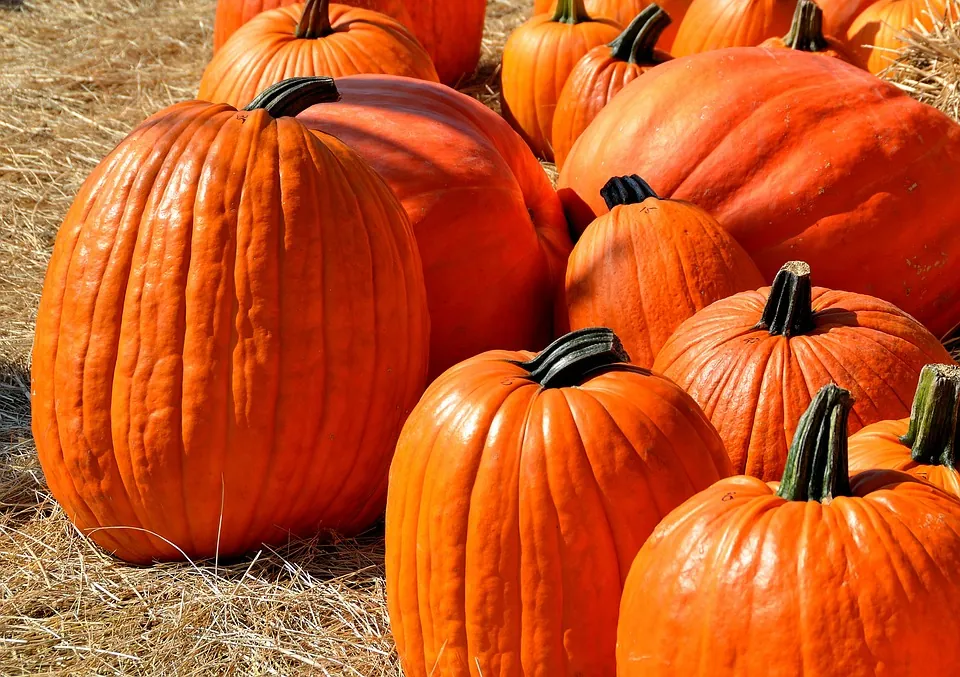
Pumpkin and its close cousin, the winter squash, are thriving during the fall season and that makes it a great time to add a little nutritional pumpkin power to your day. Pumpkins pack a powerful punch and they have some hidden nutritional benefits that you may not expect.
Vitamin A
One of the best indicators of the presence of Vitamin A is the yellow-orange coloration that can be found in foods like carrot, winter squash and of course, pumpkin.
Why should you be so concerned about adding a little Vitamin A to your diet?
Foods high in Vitamin A have been shown to…
- Protect against certain types of cancers
- Promote eye health
- Strengthen the immune system
One serving of pumpkin provides 12231 IU, or 245% daily value of Vitamin A and that also comes with 2.7g of fat-fighting fiber1. Fibrous foods are often the most nutrient-dense and they fend off those pesky cravings. Pumpkin also contains a whopping 564mg of electrolyte refueling Potassium in every serving, about 16% daily value making pumpkin a great post-workout recovery choice2.
If protection against cancer, healthy eyes, a strong immune system, a tighter mid-section and potassium-powered recovery seem beneficial to you, then throw pumpkin into the mix. Actually, a mix is how I would suggest you get started with this blended pumpkin treat.
Powerful Pumpkin Pie Smoothie
Add liquid to your blender, followed by fruit and finally all of your greens. Blend until smoothie is creamy and add a little liquid if it’s too thick.
1 cup raw pumpkin or 1/2 cup pure canned pumpkin
1 cup mango
Fist full of cashews
1 Tsp vanilla
1 Tsp cinnamon
2 cups spinach
8-10 ounces almond milk
If you liked this post:
– Pumpkin, this Season’s Superfood
References:
- Beyond Pumpkin: Harvest the Health Benefits of Winter Squash. Tufts University Health & Nutrition Letter [serial online]. November 2014;32(9):6. Available from: SPORTDiscus with Full Text, Ipswich, MA. Accessed October 7, 2016.
- Nutrition Data: http://nutritiondata.self.com/facts/vegetables-and-vegetable-products/2601/2 Retreived on 10/7/16.

About Kevin:
Kevin Dietmeyer began helping others make dramatic changes in their health with individualized personal training and coaching in 2008. He believes in building a long-term strategy for success for each individual and that nutrition and exercise aren’t a one-size-fits-all prescription.
After years of competitive tennis as a highly ranked junior in the southwest, Kevin crossed into health and fitness as a profession. He has a passion for endurance sports and has competed in more than thirteen half marathons and trail marathons. Kevin is also a triathlete who has experience running Olympic distance triathlons including the Nautica Malibu Triathlon and half iron distance events like the Ironman Raleigh 70.3.
Kevin is a student of Nutrition and Communication with Arizona State University graduating in the fall of 2016. He is a certified personal trainer with credentials from the American College of Sports Medicine (ACSM). He also carries a certification in Fitness Therapy with the International Sports Science Association (ISSA) and Stretching Principles with the National Federation of Personal Trainers (NFPT).
A Review of Quick and Nutritious Meals
By Michael Russell, recent Arizona State University Nutrition Communications Student
These days, it seems we find more and more to put on our plate, no pun intended, and we find less time to eat right. I know in my day I typically wake up with very little time to make a healthy breakfast and usually get home too exhausted to make anything that resembles a decent dinner. So what to do?
I know that it is very easy to pull off to one of the many fast food places and pick up something but after a while that will only do more harm than good. Unfortunately, there doesn’t seem to be any fast healthy food chains popping up across the United States so it is time to meet this problem head on and fix it within our own kitchens.
I’ve been doing some research on quick and nutritious meals and I wanted to share what I’ve learned.
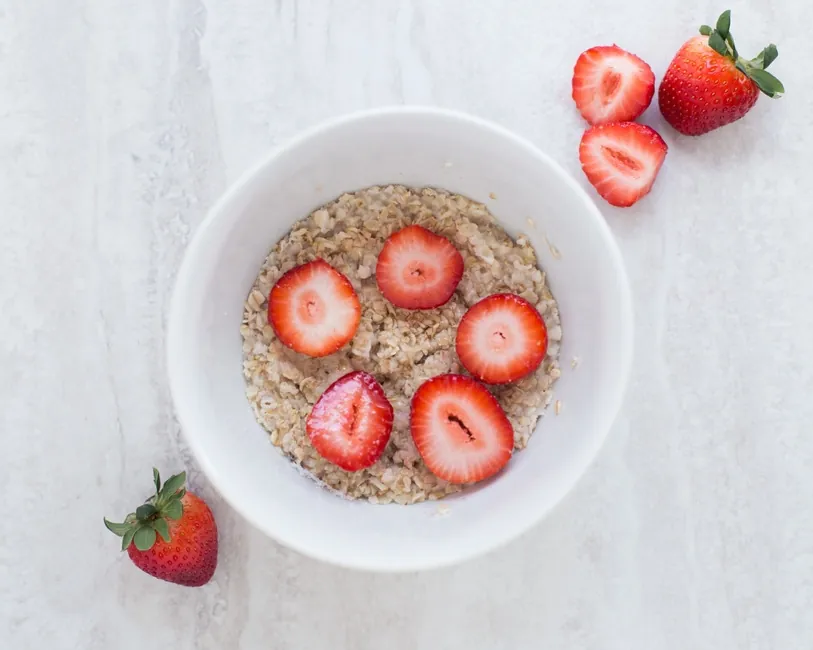
Breakfast, Famous for Being the Most Important Meal of the Day
We all know that breakfast is the most important meal of the day because it is what will get our bodies’ engines running. If we continue with that analogy and look at our body as a car, we wouldn’t want to put cheap gas in our gas tank because it will destroy the engine from within, as we shouldn’t want to put doughnuts and muffins in our body first thing in the morning. It is crucial to the rest of the day what we eat in the morning so now would be a great time to introduce some fruit and vegetable to acquire those essential vitamins and minerals to jump start your body. Here are some breakfast foods that will be easy to prepare and be full of nutrients to start your day right:
- Oatmeal: One of the heart-healthiest breakfast meals, oatmeal is a great way to start your day but plain old oatmeal is boring and not very much fun to eat so try adding fruit and nuts to add some flavor. Bananas will add fiber and potassium while walnuts will contribute some healthy fats.
- Eggs: These little, white nutrient packed guys are an “egg”cellent (sorry I couldn’t help myself) source of fatty omega-3s and protein. One could do several egg preparations in the morning but one of the easiest is an omelet. Omelets are a great way to add some vegetables and healthier cheeses to your morning meal. My favorite is a spinach, tomato, mushroom 2 egg omelet with feta cheese and a sprinkle of fresh basil.
- Greek Yogurt: All yogurts are a greats source of calcium, potassium, protein, zinc, and vitamins B6 and B12 but what sets Greek yogurt apart is it’s lower in lactose and has twice the protein of regular yogurt. It is also creamier and thicker which makes Greek yogurt a great base for smoothies and smoothies are a quick and delicious start to your day. Also, they are a great way to add fruit and vegetable to get more out of the meal. My go to smoothie is plain Greek yogurt to which I add pineapple, strawberry, spinach, and pomegranate juice.
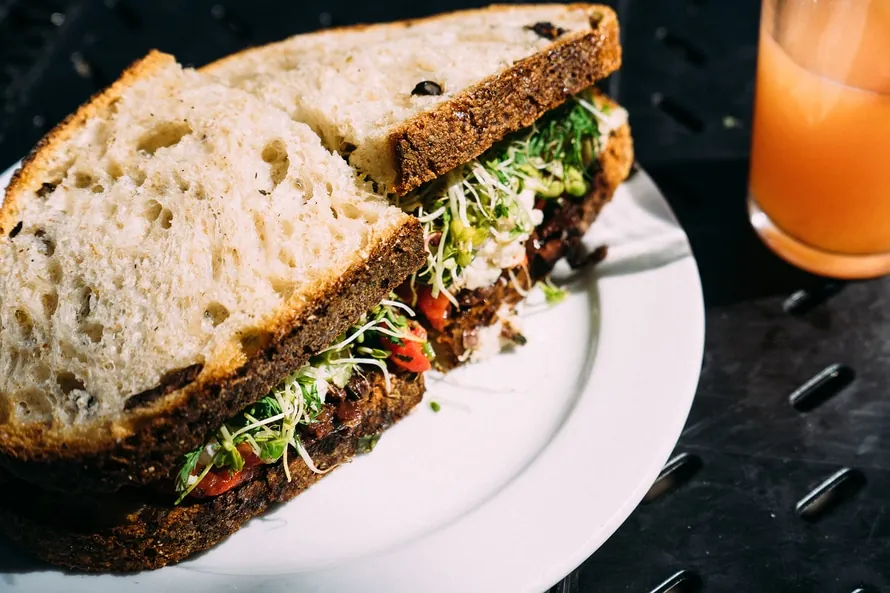
Lunch, Your Mid-Day Renewal
Lunch seems to be the meal that I skip quite often and I always kick myself for doing that because by the end of the day I have no energy and only want to sleep when I get home. The toughest part of lunch for me is preparing it in the morning or night before the coming day. But with some quick and easy meals in my arsenal I can brown bag it with pride. Let us look at some traditional lunch time meals and see how we can make them a little healthier while cutting down on time spent preparing:
- Sandwiches: This is quite possibly the most popular lunchtime staple and with a little tweaking we can make the lunch time sandwich a great mid-day energy source. First, start with whole grain bread, most of the time tastier than its white bread counterpart. Besides, cold cuts don’t forget leftover cuts of meat. If you have leftover roasted chicken, a can of tuna, or even veggies from the night before use them. Finally, dress your sandwich with olive oil or mayo cut with Greek yogurt.
- Wraps: Riding closely on the heels of the lunch time sandwich is the wrap. Look to impart more of the same principles of a sandwich building as you would in making your wrap. Whole wheat wraps, low-fat condiments, quality meat or vegetable choices make a quick and healthy meal that will power you through the second half of the day.
- Salads: Often labeled “rabbit food” salads have gotten a bad rap. There are many ways to make a salad bright, full flavored, and delicious while being quick to prepare. Start with a dark leafy green base such as romaine and spinach or kale. You can really pack on the vitamins and minerals by adding any kind of fruit to a salad. Pears and apples pair nicely with feta or goat cheese. Oranges and pineapples bring a bright flavor to an otherwise bland salad. Dressing your salad with olive oil and vinegar or cutting your creamier dressings with Greek yogurt is a healthier way to go.
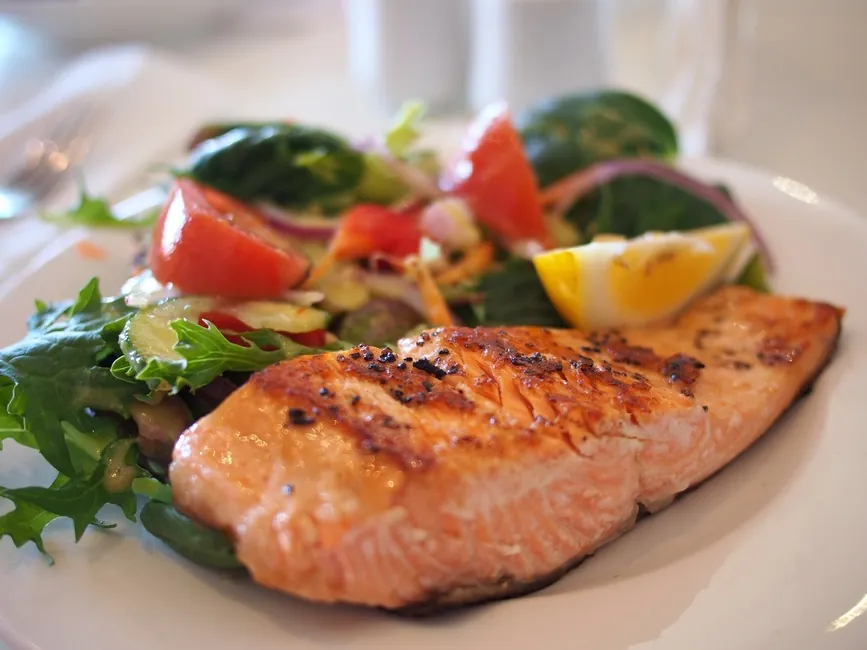
Dinner:
You’re at the end of your work day and the last thing you want to do is make a huge dinner that will take hours to cook. Well, several ways exist to make a quick dinner and also have it be delicious and nutritious.
- Soups: I was very against making soup as a main meal because I always thought it was a starter to a dinner as opposed to just dinner but I’ve learned just the opposite is true. Soups combine proteins and minerals with meats and vegetables. Often only needing about a half hour to make, soup is a great way to save time and eat right. I typically sauté garlic and shallots in olive oil and then add mushrooms and carrots with leftover roasted chicken, pour in a mixture of vegetable and chicken stock and add kale with about 5 to 10 minutes left to cook.
- Pasta: Being Italian I am genetically inclined to love pasta, but it doesn’t love me back so I tweak my recipes. I use whole grain pasta and light sauces. I use turkey meat for meat sauces. I slice vegetables and dress my pasta with olive oil for a bright meal option.
- Meats: Beef has more than 29 lean cuts and Arizona is known for producing some of the healthiest beef around. Fish is also the way to go when wanting to eat more protein. Salmon, halibut, and tilapia are all great fish choices full of fatty omega-3s. Instead of breading the fish and frying it try broiling or grilling the fish for a healthier prep option. A honey-soy glaze or citrus-soy glaze adds pop to any fish dish. Paired with steamed vegetables or a side salad you’re looking for a 20-minute meal that is a great way to end the day.
Remember to go to Fill Your Plate for some quick recipes too. But just a few basics as mentioned above means you might not even need to follow a recipe!
REFERENCES
- Best Healthy Foods You Aren’t Eating: Greek Yogurt, Canned Tomatoes, and More. (2016).
WebMD. Retrieved 24 March 2016, from http://www.webmd.com/diet/best-foods-you-are-not-eating?page=3
- Cooking Tips: Easy Dinner Recipes– Fast. (2009). Women’s Health. Retrieved 24 March 2016,
from http://www.womenshealthmag.com/food/quick-meals-in-under-30-minutes/easy-parchment-baked-halibut
- Healthy Bites: The Benefits of Dark Green Leafy Vegetables – Brain Balance Achievement Centers.
(2013). Brain Balance Achievement Centers. Retrieved 24 March 2016, from http://www.brainbalancecenters.com/blog/2013/03/healthy-bites-the-benefits-of-dark-green-leafy-vegetables/
- Kamo, M., & Kamo, M. (2015). 16 Ideas For Quick Healthy Meals – Nutrition Secrets. Nutrition
Secrets. Retrieved 24 March 2016, from http://www.nutritionsecrets.com/hack-your-health-17-ideas-for-quick-healthy-meals-2/
- Vince, S. (2015). Breathing Space: 5 Ways to Find Quiet in a World that Never Stops. Suzanne
Whitfield Vince. Retrieved 24 March 2016, from http://suzannevince.com/2015/11/breathing-space-5-ways-to-find-quiet-in-a-world-that-never-stops/
Pumpkin, this Season’s Superfood
By Lori Meszaros, ASU Nutrition Communication Student
Pumpkins have always been known for their amazing ability to withstand carving and of course to make a pie, but now pumpkin is popping up everywhere. From Starbucks’ world famous Pumpkin Spice Latte, to pumpkin bread, snacks and even beer.
It’s fall and that means pumpkin season.
Pumpkins are taking center stage in the produce section of your local grocery store and farmer’s markets. From small and ornamental to the giant carving, pumpkins are everywhere! And that’s a good thing because this fruit is actually a powerhouse when it comes to nutrition.
Nutritional benefits of Pumpkin
- Loaded with Vitamin A, one cup of pumpkin provides the body with over 200% of your RDA, which is needed to maintain healthy skin and eyes, boost your immune system, and help protect you during cold and flu season.
- Pumpkin is a rich source of the antioxidant beta-carotene, which helps prevent fine lines and wrinkles, and research supports the idea that pumpkin may play a role in cancer prevention.
- Pumpkins are high in Vitamins C and E
- Good source of fiber with more Potassium than a banana which is good for your heart. Fiber has been shown to reduce LDL “bad” cholesterol, and Potassium plays a crucial role in heart health.
- Pumpkins are a good source of complex carbohydrates, providing the body with an excellent source of energy. Helps regulate blood sugar due to low glycemic load which is important to anyone with diabetes.
- Research supports Pumpkin can help relieve the symptoms of arthritis due to its anti-inflammatory substances and has been shown to benefit the symptoms of bronchial asthma (Pitchford, 2002 & Yadav et al. 2010).
- 1 cup of pumpkin has only 49 calories and has no fat or cholesterol.
Adding pumpkin to your diet is easy and doesn’t just have to be limited to desserts and snacks. Try substituting your normal roasted vegetables with some roasted pumpkin. I love to add roasted pumpkin to my salads.
This Roasted Pumpkin and Chickpea Salad is one that I made for Thanksgiving dinner. I’m usually responsible for making the pumpkin pies, but last year I wanted to mix things up a bit. My guests loved the twist and were pleasantly surprised by the pumpkin making an appearance before dessert.
Roasted Pumpkin and Quinoa Salad
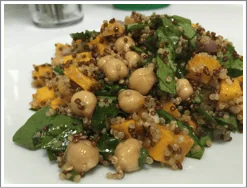
Ingredients
2 cups Butternut pumpkin/squash
2 cups Chickpeas, drained and rinsed
2 cups cooked quinoa
2 cups torn spinach
1 small red onion
1 tsp sea salt or rock salt
1 tsp chili powder (optional)
Marinade
2” piece ginger, peeled
1 garlic clove
1-2 small red chilies, deseeded if mild or leave in seeds for hot
1 tbsp. veggie stock concentrate or 1 bouillon cube crushed
⅓ cup water
Dressing
2 tbsp. balsamic vinegar
4-5 tbsp. cold pressed olive oil
1 tsp Dijon mustard
1 tsp agave nectar or honey
Method
- Preheat oven to 400F
- Start by preparing the marinade. Put all ingredients in a NutriBullet or high-speed blender. Blend until smooth.
- Cut pumpkin into bite size pieces, add to a mixing bowl with marinade and toss to coat.
- Place coated pumpkin on a cookie sheet lined with baking paper and bake until a fork inserts easily, approximately 10-15 minutes. Once cooked, remove and set aside to cool.
- To make the dressing, add all ingredients to a small bowl and whisk until emulsified, set aside.
- Add cooked pumpkin, chickpeas, quinoa, torn spinach and red onion a bowl, then toss with dressing.
The salad is best served at room temperature.
Enjoy!
This salad is also a great source of plant protein. Quinoa is the only grain, or seed depending on how you see it, that contains all 9 essential amino acids that are needed to make up a complete protein. In addition, quinoa is a good source of unsaturated fat that contains more calcium than milk, along with being a very good source of iron, phosphorous, B vitamins and vitamin E (Pitchford, 2002).
For more pumpkin recipes go to Fill Your Plate.
References
- American diabetes Association, Glycemic Index and Diabetes. Viewed October 5, 2016. http://www.diabetes.org/food-and-fitness/food/what-can-i-eat/understanding-carbohydrates/glycemic-index-and-diabetes.html
- Harvard Health Publications, Heart failure and potassium. Viewed October 6, 2016. http://www.health.harvard.edu/heart-health/heart-failure-and-potassium
- National Cancer Institute. Antioxidants and Cancer Prevention. Viewed October 5, 2016. https://www.cancer.gov/about-cancer/causes-prevention/risk/diet/antioxidants-fact-sheet
- Pitchford, P. Healing with whole foods, 3rd 2002. North Atlantic Books. Berkley, CA.
- Self-Nutrition Data, Pumpkin. Viewed October 5, 2016. http://nutritiondata.self.com/facts/vegetables-and-vegetable-products/2601/2
- How fiber protects your heart. Viewed October 6, 2016. http://www.webmd.com/diet/features/fiber-heart#1
- Yadav, M. et al. Medicinal and biological potential of pumpkin: an updated review. Nutr Res Rev, 2010; 23:184-190.

About Lori
Lori’s passion for food began when she was a little girl. Growing up on a small farm in Goodyear, AZ, she would follow her grandpa around the garden and watch her grandma in the kitchen. Lori’s curiosity and love for gardening and cooking led her down the path to pursue her passions. After studying Nutritional Medicine in Australia, and now studying Nutrition Communication at ASU, Lori plans to continue her studies to receive her Masters in Nutrition, taking her knowledge into the classroom to educate young minds about the importance of their food choices. Lori has strong beliefs that the food choices you make directly impact your health and eating local, fresh produce is the best prescription to better your health. Lori dedicates most of her free time to creating all of her favorite dishes with healthy, whole food ingredients in hopes to encourage future generations to live healthy, active lifestyles one meal at a time.
Of Hummus and Children
By Nathan Chambers, ASU Nutrition Student
“Time for bed, please brush your teeth,” her mother will call from our bedroom down the hall.
A brief hesitation and then, “It’s only 8:48. Yesterday you didn’t ask me to brush my teeth until 8:55, so I still have….” Another momentary hesitation where, in my mind, I can see her using her fingers to count. “Seven minutes!” She says. Though, by the time she has figured this out her time has dropped to six minutes.
At this point I am regretting the recent wristwatch purchase.
My precocious eight-year-old is testing her independence… and our sanity. An issue that always comes up is acceptable foods. One day goulash is her favorite food, the next she hates it and always has.
“You ate goulash two weeks ago, and you loved it!” I will say, “Just eat your mother’s goulash please.”
“Well, I don’t like it anymore. It tastes different this time.”
Ah. Well, there’s the problem. It tastes different this time. Why didn’t I think of that?!

Finding What Works
It difficult to find a recipe that works for everyone. Mom and Dad want it to be healthy (and preferably easy to make) and Daughter wants it to taste good.
Now, her mother and I do not eat a lot of meat… we often will have things like bean salads or rice and beans as a protein food staple. One of my personal favorites is hummus. But how to get her to eat hummus?
I wish I could claim this idea was mine, but it wasn’t. I did what every responsible parent does in a time of child-crisis. I Googled it. Turns out, coercing your child into eating hummus is as simple as two letters: P and B.
Maybe, just don’t call it hummus when you present it to your child. Those sensible child-ears will pick out that one word, delicately weighing the implications in their minds. It won’t take them long to realize you are trying to make them eat something they know that they don’t like. Oh they may have never heard of hummus before, but they know it’s bad!
Now this part was my idea… but please feel free to take it. Call it peanut butter dip. And then just walk away. Give them some carrots, or celery, or pita bread. Sit it on the table next to their peanut butter dip and say nothing else.
Don’t even look at them. Just turn around and mind your own business. Nothing new here. Nothing weird. It’s just peanut butter dip and celery.
I pray that it works for you like it has for me. Us parents… we need to stick together.
Any hummus recipe will be fine, just replace the tahini with peanut butter. It gives a familiar flavor to the kids while still providing some good fiber and protein.
For my daughter, I keep the ingredients basic. I add less garlic and cumin than I do when making hummus for myself. And I process that sucker until it is as smooth as silk. Make it look as much like peanut butter as possible. No drizzled oil or dash of paprika for serving. Just nice, super smooth peanut butter dip (remember, it’s not hummus!).
Here is a basic ‘Peanut Butter Dip’ recipe:
1 Can Garbanzo Beans, (keep half of the liquid)
1 Clove Garlic
2-3 Tbs Smooth Peanut Butter (organic and no salt added is my preference)
1 Lemon, Juiced
⅓ Cup Olive Oil
½ tsp Ground Cumin
Pinch of Salt
Directions: In a food processor, add finely chopped garlic, garbanzo beans, and reserved liquid. Process until smooth.
Add peanut butter, lemon juice, cumin, and salt to the mixture and process until you have a nice paste. Drizzle in olive oil and continue to process until you have a smooth puree.
About Nathan:
Nathan is an Arizona State University senior in his final semester of the nutrition communication degree program. He is a writer of both fiction and non, and a voracious reader of both. He is a Realtor in the South East Valley just outside of Phoenix, AZ but can often be found at Dunkin’ Donuts, Starbucks, or just in his home office plinking away at the keyboard. Nathan’s goal is to create enough written content to build a sustainable business as a full time writer. Nathan’s social life and hobbies are predominantly predetermined by his wife and eight-year-old daughter, though he does enjoy the occasional mountain bike excursion or cruising down the highway on his Suzuki.

The Mediterranean Diet: Heart Healthy and Delicious
By Michael Russell, recent Arizona State University Nutrition Communications Student
Becoming a nutrition communications student has introduced me to several wonderful diets and reasons to start eating healthier. As a part of one particular class we had to choose a diet, live by it for a week, and report on our success. As I thumbed through the diet choices one stuck out at me because of its emphasis on heart health. That diet was the Mediterranean Diet.
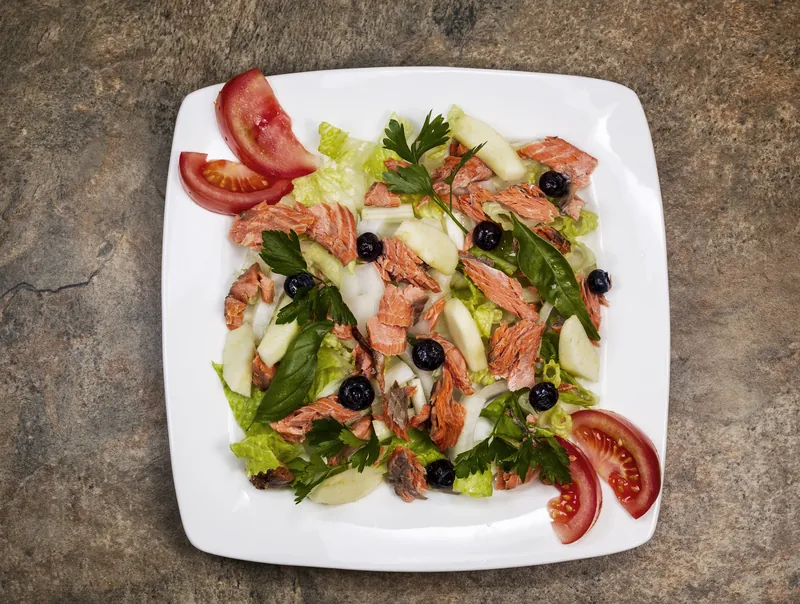
Our hearts play a vital role in supplying our essential organs with oxygen rich blood; it is our engine. If you put the wrong fuel into your car engine then over time it will gunk up and stop working, well our hearts will do the same thing if we continue to put unhealthy food into our bodies. The Mediterranean Diet helps us choose healthy proteins, fats, and oils to keep our heart running at its optimum level.
The Mediterranean Diet
This diet originates from the foods eaten by those bordering the Mediterranean Sea, so areas like Southern Italy, Greece and Crete. In our minds we think of these countries eating foods like pizza, gyros, falafel, and drinking several bottles of wine. That theory is simply not true and is due to an American lifestyle of adding in calories to pump up meals to fill our growing nation, according to the experts.
The Mediterranean Diet is based on limiting red meats and sweets and eating a lot of fish, fresh vegetables, nuts, and whole grains. They choose to eat basic foods instead of processed foods and include daily exercise and sharing meals with loved ones. Yes, they do drink red wine but one to two glasses, not a bottle and choose red wine over hard liquor. Let us take a look at some of the health benefits the Mediterranean Diet is aligned to:
- Protects against type 2 diabetes. Because of its use of fresh vegetables, it introduces a greats source of fiber which can help to prevent huge swings in blood sugar.
- Helps prevent heart disease and stroke. As I mentioned before with the diet’s choice to eat whole grain as opposed to refined breads, homegrown and basic foods instead of processed foods, and drinking a glass or two of red wine versus hard liquor, this diet shows links to prevent heart disease and stroke.
- Keeps you agile in your later years. As we age our muscles become weaker due to inactivity and poor diet. The Mediterranean Diet has shown to increase muscle strength and other signs of frailty in seniors by 70 percent.
- Reduces the risk of Alzheimer’s. Alzheimer’s has been linked to an increase in cholesterol and blood sugar levels as well has poor blood vessel health. All these factors are improved by adopting the Mediterranean Diet.
- Helps to halve the risk of Parkinson’s disease. This diet is high in antioxidants, because of this reason our body has a lesser chance of going through the process of oxidative stress which practically cuts the chance of Parkinson’s in half, according to those who have researched this diet.
Because of these great health benefits and also that a diet like this helps to protect the body from developing a host of cancers our chance of a long and enjoyable life is greatly improved.
How to Follow the Mediterranean Diet:
I have already mentioned some diet choices the Mediterranean Diet follows but I want to go in depth on the choices we should make in order to live according to this particular diet:
- Vegetables are key. By now, we should know the health benefits of eating vegetables. They provide an excellent source of fiber which in important to healthy digestive tract as well as lower our blood sugar levels. Try eating a plate of sliced tomatoes drizzled with olive oil, lightly salted with some feta cheese or top a pizza with an assortment of roasted vegetables such as eggplant, peppers, garlic, and shallot as opposed to pepperoni and sausage. Salad, soups and stews are also a great way to get more vegetables into your diet.
- Balance your meat intake. We now have more than 29 cuts of lean meat in beef. Portion size is key. You don’t need to overeat on your red meats. Plus, a variety of meats like lamb, pork and chicken should all be considered.
- The most important meal of the day. Breakfast is essential to starting your day off right and instead of eating two or three doughnuts followed by a gallon of coffee try whole grains and fruits. Eating these types of foods at breakfast will keep you feeling full for hours and treat your body right.
- Cast a line. Try to eat fish at least twice a week. Fish like tuna, salmon, herring and black cod are all rich in Omega-3 fatty acids, the good fat. For those of you who love shellfish, oysters, mussels, and clams can help with heart and brain health. Choose a whole grain pasta and top it with mussels cooked in a white or red sauce with plenty of garlic and a crunchy whole grain loaf of bread for dipping.
- Eat a vegetarian meal once a week. Once a week build a meal around beans, vegetables, and whole grains. At a minimum try to have an array of vegetables on a regular basis.
- The right kind of fats. Healthy fats can be found in such options as extra-virgin olive oil, avocado, nuts, sunflower seeds, and olives.
- Enjoy dairy products. Research has shown that full dairy products have been proven to make you feel fuller faster so ingesting natural cheeses and Greek yogurt may lead to less body fat and lower levels of obesity.
- How about dessert? This may be the true test for some us because having something sweet after dinner is almost a given but instead of eating cake and cookies try a bowl of fresh fruit. I know this may sound boring but if you couple some dairy with your fresh fruit it could change the way you look at fruit as a dessert. For instance, try grilling peaches to caramelize their natural sugars, remove the pit and add some vanilla Greek yogurt in the middle.
Eating right is a start but the Mediterranean Diet also includes daily exercise and eating with loved ones. These two lifestyle changes can help to stave off depression and unwanted pounds. I know I want to live a full and healthy life and the Mediterranean Diet will help me achieve that goal.
REFERENCES
- Mediterranean Diet 101 | Oldways. (2016). org. Retrieved 9 April 2016, from http://oldwayspt.org/resources/heritage-pyramids/get-started-go-med.
- Mediterranean diet for heart health – Mayo Clinic. (2016). org. Retrieved 9 April 2016, from http://www.mayoclinic.org/healthy-lifestyle/nutrition-and-healthy-eating/in-depth/mediterranean-diet/art-20047801.
- The Mediterranean Diet | The State Times. (2016). com. Retrieved 9 April 2016, from http://thestatetimes.com/2015/04/01/the-mediterranean-diet/.
- The Mediterranean Diet: Myths, Facts, and Health Benefits of a Mediterranean Diet. (2016). org. Retrieved 9 April 2016, from http://www.helpguide.org/articles/diet-weight-loss/mediterranean-diet.htm.
Soup News
By Angela C Torrence, Recent ASU Nutrition Student
The season for soup will soon be here. I am so excited to make new combinations of vegetables, broth, herbs and seasonings! There is nothing more satisfying than a great bowl of warm soup and some hearty bread as the weather cools. A healthy love for soup is a great thing! One study put out by the British Journal of Nutrition found that if you eat soup, you might be ingesting less calories and have an overall better diet quality!

The study found that soup consumers had a lower waist circumference and a lower BMI. People who consumed soup had a lower intake of fat, and a higher intake of minerals such as phosphorus, magnesium, iron, copper, and potassium, but they also had a higher intake of sodium. The study looked at the food groups including fruit, vegetable/legume, and whole grain intake by non-consumers and soup consumers and found that the overall diet quality of soup consumers was higher than non-consumers. In fact, it was found that soup consumers had a higher intake of dietary fiber which helps with controlling blood sugar and helps with GI health too!
All of these findings go to show that if you want this comfort food, go ahead; make it! Soup can even act as an appetite-suppressant for a short period of time. It is great for hydration because it has so much water, but be careful not to add too much salt. The research identified higher levels of sodium in soup consumers compared with non-consumers.
One of my favorite soups is a vegetable lentil soup largely from a Martha Stewart recipe but slightly modified to my preferences. It is warm, hearty, filling, and really hits the spot with some excellent bread and olive oil.
Vegetable Lentil Soup
2 1/2 tablespoons extra-virgin olive oil
1 onion, chopped (3/4 cup)
2 carrots, peeled and chopped (3/4 cup)
2 celery stalks, peeled and chopped (2/3 cup)
3 garlic cloves, minced (1 tablespoon)
1 tablespoon coarse salt
1 small tomato, chopped (1/3 cup)
1 tablespoon tomato paste
2 cups brown or green lentils
2 teaspoons cumin
1 teaspoon dried thyme
1 bay leaf
ground black pepper
6 cups chicken broth or vegetable broth
4 cups water, plus more if needed
Heat a large soup pot over high heat and swirl in the olive oil. Add the onion, carrots, celery, garlic, cumin, and 1 teaspoon of salt. Reduce the heat to low and saute until the vegetables are lightly caramelized, about 5 minutes. Add the tomato and cook for 2 minutes. Stir in the tomato paste and cook for another 2 minutes.
Add the lentils, thyme, bay leaf, pepper, and the remaining salt. Add the broth and water, and bring to a boil, skimming and discarding any foam as it rises to the surface. Reduce the heat and simmer until the lentils are tender, 15 to 20 minutes. (The cooking time depends on the age of the dried lentils.) Season to taste with salt and pepper. If needed, thin the soup with additional water or broth for the desired consistency.
If you don’t take some time out of your life to learn a few really great soups to enjoy, you are really missing out! Try this one to start, and make it your own. Enjoy!
More soup posts from Fill Your Plate:
Mini Pear Pies: A New Fall Favorite
By Lisa Kaschmitter, recent Arizona State University Nutrition Student
Fall is just around the corner and for those of us in love with this time of year, we’re already gathering our favorite recipes with plans to cook. A fall favorite of my entire family has always been pumpkin pie. We look forward to it all year, so this fall the possible pumpkin shortage has been the topic of conversation more than once around the dinner table. This possible shortage stems from Illinois where nearly ninety percent of the pumpkins in the U.S. are grown. Illinois has experienced heavy rains this year that have wiped out and delayed pumpkin crop growth throughout the state. This means that canned pumpkin at the grocery store may be in short supply this season.
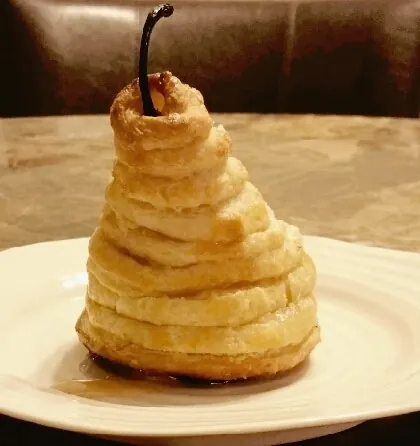
Although it is hard to beat pumpkin pie for my family, we decided that this year we would be prepared to try something new. There is a long list of pie worthy fillings that are in season during the fall: sweet potatoes, apples, pears, and figs are all great choices. Personally pears are one of my favorite healthy fall flavors, and one medium pear boasts 6 grams of fiber, 206 mg of potassium, vitamin B6, magnesium, and vitamin C.
I recently discovered a recipe for mini pear pies, from Paul Hollywood that was featured on The Great British Bake Off. These pies are so beautifully unique looking that I couldn’t wait to try my hand at making them. I combined Paul’s recipe for poached pears and syrup, while utilizing a recipe for puff pastry by Winnie Abramson that I had used in the past with success.
One of my favorite things about this recipe is that if utilizes pears while they are in season and at their peak of nutrient retention and freshness. It is also great that these are designed to be individual pies, so each person gets a whole piece of fruit, and there is no fussing with trying to get that first piece of pie out of the pan! Also everything can be prepped ahead of time. The puff pastry, poached pears, and syrup will all be fine in the refrigerator for a few days before your event, just leaving assembling and baking for the day of!
The puff pastry dough is the most difficult part of this recipe. It is important that puff pastry dough remains cold during the whole process, so it each time if got a little too warm, I had to stop for 30 minutes so that the dough could chill in the refrigerator. It would simplify the process to use frozen puff pastry from the store, however, many store bought puff pastries have added ingredients and preservatives that you would not include if made at home.
*makes 6 pies
Ingredients
For the puff pastry
- 2 ½ cups unbleached all-purpose flour
- 1 ¼ cups cake flour
- ½ tablespoon salt
- 1 ¼ cups very cold water (I chilled with ice and strained immediately before use)
- 1 pound very cold unsalted butter
Preparation:
- Combine flours, and salt into a food processor. If your food processor will not hold all ingredients make the dough in two batches and combine. Pulse the food processor until flours and salt are just combined.
- Add all water into the processor and pulse until a ball of dough forms. The dough should feel moist and when squeezed should hold together.
- Remove the dough and form it into a ball.
- Wrap the dough in a damp towel and refrigerate for at least 5 minutes.
- While dough is chilling, place butter between 2 sheets of plastic wrap. Beat the butter with a rolling pin until it flattens into a square that is about 1 inch thick. The butter needs to remain cold, so if you notice softening or oiliness forming, place in refrigerator or freezer and allow the butter to chill before continuing.
- Unwrap your dough and roll out on a lightly floured surface into a 10-inch square. Place the chilled butter in the center. Fold and stretch the dough to fully encase the butter inside the dough. (Remember it is important for this dough to stay cold. To keep your dough cold you can stop at any point, cover the dough in plastic wrap, and place it in the refrigerator.)
- Roll the dough into a rectangle that is approximately 24 inches long. Fold this rectangle by thirds, like you would fold a letter. Rotate the folded dough to the left so that the closed fold is on your left.
- Repeat the process of rolling out a 24-inch rectangle, folding it in thirds and rotating it. I chilled my dough after this second time for 30 minutes.
- Remove the dough from the refrigerator and roll out 4 more times, chilling when needed.
- Chill pastry dough for at least an hour.
For the poached pears
- 6 large, firm pears (preferably ones that are straight and tall)
- 1 ½ cup sugar
- 18fl oz dry white wine
- 2 cinnamon sticks
- 1 orange zest only
Preparation method
- Peel the pears, keeping the stems intact.
- Combine 14fl oz water, the white wine, cinnamon, orange zest, and sugar, slowly bring to the boil, stirring until the sugar is dissolved. Boil for three minutes.
- Add the pears to the pan. Bring back to the boil, reduce the heat to a simmer and cook for 15 minutes. Reserving the syrup, remove the pears from the pan with a slotted spoon and set aside to cool on kitchen paper. Using a melon baller or small teaspoon remove the core from the pears.
- Return the syrup to the heat and boil rapidly for 10-15 minutes until the volume of the liquid is reduced by half and the syrup is thick. Remove from the heat and set aside to cool.
- Chill the poached pears until cold.
Putting it all together
- Preheat the oven to 400F.
- Using a sharp knife and a ruler cut the pastry into long strips ½ inch wide. You will need about 18-20 strips.
- Brush the pears with the cooled sugar syrup and starting from the bottom, wrap the pastry strips around the pears. When you come to the end of the pastry strip, brush the end lightly with syrup and press to adhere to the next pastry strip. Continue wrapping until you reach the top of the pear. (Three strips should cover each pear). Tuck the end of the last pastry piece behind the previous dough spiral.
- Place the pastry-covered pears on a baking tray. Brush the pastry with beaten egg and sprinkle with the granulated sugar. Bake for 25-30 minutes.
- Remove from the oven and leave to cool for 10-15 minutes then serve with a drizzle of the reduced sugar syrup.
Whether you are enjoying the fruits of your labor on a quiet night at home, or at a fall get-together, these mini pear pies will impress all with their uniqueness, beauty, and mostly their flavor! Dig in!
If you liked this article, try this one too: 50 Ways to Use Pears
Recipe sources
Mini Pear Pies:
http://www.bbc.co.uk/food/recipes/mini_pear_pies_77186
Puff Pastry:
http://www.healthygreenkitchen.com/homemade-puff-pastry.html
Fun Summer Snacks
By Laura Slatalla, ASU Nutrition Student
Having the kids home during the summer means they’ll be playing hard and get extra hungry, so it’s a great time to try some new and exciting snacks! Break out of the crackers or cookies and try out some high fiber and protein snacks or fruity treats.

Avocado Toast
Spread some avocado on whole wheat toast and sprinkle with mozzarella cheese or add an egg! It’s super filling and tasty. The whole wheat has fiber, avocado has healthy fat, and cheese or an egg will have some protein.
No Bake Granola Bars
Ingredients:
2 ½ cups puffed brown rice cereal
2 cups instant oats
½ cup raisins or other dried fruit
¼ cup brown sugar
½ cup honey
½ cup peanut butter
1 teaspoon vanilla
- Put cereal, oats, and raisins in a bowl
- Boil brown sugar and honey in a small pan
- Stir in peanut butter, then vanilla
- Mix with cereal, oats, and raisins
- Press into a 9 x 13 inch pan
- Cool and cut into bars
Ants on a Log
I’m sure most of us remember this classic from childhood! It’s fun and easy. Wash some celery in cold water to freshen it up. Shake it dry and cut into 3 or 4 inch pieces. Add a little peanut butter and top with raisins. The kids can help make this one!
Fruit Salad
Slice up some of your favorite fruits and keep them refrigerated for a quick snack. I like to have a base fruit, like pineapple or watermelon, and add berries, grapes, or apples. Adding a little honey and lemon will keep the apples from browning and make it a little more interesting. Try adding some fresh mint too!
Homemade Popsicles
These can be made from juice or leftover smoothie. You can find molds at the supermarket, even some cute shapes if you look! They make a great treat that are lower in fat than an ice-cream cone.
Nutrition Series: Teens
By Mariely Lopez, A Nutrition Communication Undergraduate at Arizona State University
Part four of a four-part series.
Part three: Toddlers and Preschoolers
As your child enters his or her teen years their bodies being to change and what they put in their bodies can influence their lean body mass, skeletal mass, and body fat in major ways, as their bodies begin to mature.
As parents or legal guardians it’s important to note what a growing teen body needs during puberty in order to maintain a state of well being. As you read along, be sure to note why each nutrition component: energy, protein, carbohydrates, dietary fiber, calcium, vitamin D, iron, and folate—is essential for your child and why we must guide them along the way.

Energy
We all need it. We require energy from the moment we come into this world in order for our bodies to function properly. Teens, for the most part, are highly active and due to their high activity they require more energy than at other stages for our lives. Another reason why teens require more energy is to help pubertal progression and development.
Gender is also one of the key contributors to take into consideration when it comes to energy increases. Males 14 to 18 years old, who are moderately active, require an estimated energy recommendation of about 3,152 calories a day; females, who are moderately active, require about 2,368 calories1.
If teens do not meet their nutritional requirement intakes then they will most likely have delayed sexual maturation and may have linear growth delays.
Protein
When children move into their adolescence stage their bodies grow and develop at lightening speeds. Increasing protein intake allows for your growing teen to maximize additional lean body mass during their growth spurt.
Protein, for most teens, requires a higher intake than most adults, which is about 0.85-g/kg-body weight/day. This simply means that teens (14 to 18) require between 46-52grams of protein per day. It may seem as though it is not much but in the large scheme of things it makes a great difference1.
Carbohydrates
As stated earlier, energy is important for growing bodies. Carbohydrates are found in foods such as fruits, vegetables, whole grains and legumes.
The estimated recommendation for teens is about 130 g/day or about 45-65% of their daily energy needs. However, a large portion of carbohydrates consumed by teens comes from added sugars, but to be more specific, about 21 percent of teen’s carbohydrates comes from candy, baked goods, and soft drinks1.
This is an unhealthy way to get “carbs.” Added sugars need to be limited because they can lead to major health complications in the long run. Research is showing high incidents of diabetes and other related diseases as a result of these poor choices.
Fiber
The recommendations for fiber are different for teen girls and teen boys. Typically teen boys require more fiber than teen girls. The recommended intake for males is 31 g per day and for females it is 26 g per day1.
Fiber plays a huge role in the prevention against a number of different chronic diseases such as hypertension and diabetes. Aside from it aiding in the prevention of some chronic disease it has also been thought that fiber can help with cholesterol and sugar levels, and decrease the threat of obesity.
Calcium
If there is anything that I want you to take from this reading, it is the importance that calcium has on your teenager’s body. Calcium is critical to their health, as it is a unique contributor to your teen’s growing bones. Over half of their bone mass occurs in their teen years, so it’s important that teens get the recommended calcium intake in order for them to maximize and/or meet their peak bone build. If they meet their required dietary intakes of calcium your teens will also reduce their risk of future fractures and they will minimize the chances of osteoporosis.
Like protein and fiber, calcium is also different for both male and female teens. For males it is recommended that they consume about 1300 mg per day and for females it’s important that they consume about 948 mg per day1.
Vitamin D
Along with calcium, it’s also important to know that vitamin D is just as important. Vitamin D facilitates, or helps with, the absorption of calcium. This vitamin synthesizes the body through sun exposure and is critical to bone formation. The reason why I categorized vitamin D with calcium is because if your teenager is vitamin D deficient then it can result the lack of reabsorption of calcium in the gastrointestinal tract, which can result in bone demineralization; this in turn, can lead to health complications like systolic blood pressure and or obesity1.
Iron
Puberty, growth, and the increase of blood volume that occurs during teen years utilize and increase the demand for iron. The amounts in which iron is recommended differentiates with age. Iron needs will be the highest during puberty, which would be the growth spurt among teen boys and after teen girls get their first menstrual cycle. It is important to speak to your family physician to get the appropriate recommended intakes of iron, since they fluctuate with age.
Folate
The recommendation for both teen boys and teen girls is the same: 400 mg per day. However, folate plays a much larger role in teen girls. Folate deficiency can increase the chances of their own children having spina bifida and also increases the chance of giving birth to a baby with Downs syndrome1. Although folate plays a major role among teen girls, teen boys need to make sure they are meeting the recommendations because it can affect them, and teen girls as well, in sexual maturation.
Teen years are the most critical years because it’s where teenagers do most of their growth and development; it is the foundation for maintaining and living a long and healthy life. And as I mentioned earlier, if there is one thing that I want you to take from this reading is that calcium and vitamin D work together to help aid in bone formation. Of course everything that I have mentioned is important and should be followed if you want your child to be strong and healthy.
Remember, you can find healthy recipes on Fill Your Plate.
- Brown, Judith E., and Janet S. Isaacs. Nutrition through the Life Cycle. Belmont, CA: Wadsworth, CENGAGE Learning, 2011. Print.
Nutrition Series: Toddlers & Preschoolers
By Mariely Lopez, A Nutrition Communication Undergraduate at Arizona State University
Part three of a four-part series.
Toddlers and Preschoolers are often hard to please especially when it comes to introducing them to new foods. The Academy of Nutrition and Dietetics suggests that in children between the ages of two to 11 years need to reach ideal physical and intellectual maturity by managing a healthy weight, enjoying food, and reducing the risk of chronic disease through appropriate eating customs and physical activity. It’s easier said than done.
For most of us, children are picky eaters and often times it can be difficult to make sure they are getting all of the required recommended intakes of essential nutrients such as iron, fiber, fat, and calcium. So, here are the reasons why these nutrients are essential for growing children and how you can introduce them to each one.

Iron
Iron is necessary in order to prevent iron-deficiency anemia. The role that iron plays in our body is important because it aids blood cells carrying oxygen to the body and it is also plays an important role in brain and muscle function. Iron-deficiency anemia is prevalent among children, which is important to make sure your toddler and/or preschooler gets enough iron through different foods2.
Foods that ensure iron in the diet: Ground and/or chopped lean meats are a great source of iron for children because it makes it easy for children to chew. Peas and dried beans would also be a great source of iron along with “toddler” milk and/or iron-fortified formulas. However, if your child is already eating a variety of foods and if their milk consumption is less than 24-ounces of milk per day then they most likely do not require formulated beverages because they are obtaining their iron through a variety of foods1.
Fiber
Fiber plays multiple roles in a child’s life as well as adults. Fiber has been associated with the prevention of a number of different chronic diseases such as the following:
- Heart Disease
- Certain Cancers
- Diabetes
- Hypertension
It has not been determined if consumption of fiber at a young age can prevent the listed chronic disease when they become adults but it has been proven that fiber can prevent them as a whole, which is why we must teach children early on the importance of fiber and how it is essential for their health, now, and in the future. We want to teach children healthy eating habits and consuming fiber is one of them. Fiber has been proven to prevent constipation.
Foods that ensure iron in the diet: It is important to get children into healthy eating habits but, we must also keep in mind that having too much fiber in a toddlers diet can be disadvantageous and in turn affect their growth; that’s why it is important to know that the recommended fiber intake for toddlers is 19 g/day and for preschoolers it is 25 g/day, which can be met by introducing them to fruits, vegetables, whole-grain breads, and cereals1.
Fat
Typically, fat recommendations can be met if your child’s diet consists of fruits and vegetables, dairy products (2 years and older), whole-grain cereals, beans and peas, and lean meats. Foods that contain saturated and/or trans fats are ones we need to look out for and limit their intake on them.
Foods that ensure iron in the diet: Fat is essential for your child’s energy needs, however, the types of fat that are required are fatty acids and fat-soluble vitamins, which are vitamin A, D, and K; these types of fats can be found in peanut, corn, and canola oil, along with whole eggs, sun exposure, vitamin D fortified, and whole eggs, and in plant and animal foods.
Calcium
As children begin to grow they become curious of their surroundings and in turn grow the need to want to explore new things. In order to accommodate their curious minds and physical ability to explore new areas it’s important that their calcium needs are met. Calcium is a major contributor during childhood because it affects peak bone mass later as they enter their teen years. Having a high bone peak mass helps in the long run when it comes to fractures and protection against osteoporosis.
Foods that ensure iron in the diet: The recommended intake of calcium for children 1 to 3 years of age is 700 mg/day and for children 4 to 8 years of age it is 1000 mg/day1. Dairy products would be considered a great calcium source along with canned fish, kale, bok choy, and calcium-fortified orange juice.
Introducing Toddlers & Preschoolers to New Foods
Introducing toddlers and preschoolers to new foods can be a difficult task to take on. However, there are ways to get your child to eat new foods.
- One way to incorporate a healthy food into your child’s diet is by serving the new food with a food that they are familiar with; by doing this your child will familiarize themselves with the new food and be more prone to try it.
- Another way to get our child to try new foods is if you try it with them and encourage them to do the same. Your child looks up to you and if they see you eating healthy and a variety of different foods then it is more likely for them to do the same as well.
- A third way to get your child to eat different foods is by allowing them to pick the new food. Lay out new foods like fruits and have them pick it out; if they pick it out themselves they are more likely to eat it as well.
- Arizona Farm Bureau’s Government Relations Manager, Ana Kennedy, relates a story about her half-sister: “My half-sister used to grate all sorts of vegetables to mix in with various meals she prepared for her two boys. These boys are now grown men with their own families and during a recent visit with my sister she said one of her boys said, ‘Mom, we are all grown-up now; you don’t have to keep grating up the vegetables!’”
- The last way to get your child involved is by allowing them to get involved in the kitchen with you. Simple tasks like rinsing lettuce to prepare a salad can make a huge impact on whether or not they will eat the new foods being introduced to them. The more variety of foods your child consumes the more likely they are to meet the required dietary guidelines.
The healthy foods you introduce to your child today will make a lifetime of difference. If you eat healthy, they’ll eat healthy. Go to Fill Your Plate to discover a variety of healthy recipes for your family to try.
Brown, Judith E., and Janet S. Isaacs. Nutrition through the Life Cycle. Belmont, CA: Wadsworth, CENGAGE Learning, 2011. Print.
“Iron-Deficiency Anemia.” KidsHealth – the Web’s Most Visited Site about Children’s Health. The Nemours Foundation. Web. Apr. 2016. <http://kidshealth.org/en/parents/ida.html>.
Nutrition Series: Pregnancy
By Mariely Lopez, A Nutrition Communication Undergraduate at Arizona State University
Part two of a four-part series.
During pregnancy women’s bodies change and with this change it is important to know that what we put into our bodies may also change. Changes in diet can be different for each woman going through a pregnancy; it all depends on their body size, physical activity, stages of pregnancy, and health status. When it comes to nutrition during pregnancy it is important to know what is required in order to have a healthy baby, but for the most part eating a well balanced diet will allow for that.

Energy
We need energy in order for our bodies to function properly, when a woman becomes pregnant the need for energy increase due to the growing fetus inside of her. The fetus accounts for about one third of the increased energy needs of pregnancy. It has been estimated that the increased energy averages about 300 calories a day. Now, this is simply a rough estimate and it does not apply to every woman because every body is different. So, what does 300 calories of look like? I’ve compiled a list of meals that contain about 300 calories1.
Breakfast: 394 calories
- 1 whole wheat English muffin
- 1 hard boiled egg
- ½ cup of fruit
- 8 oz fruit juice
- 8 oz water
Lunch: 305 calories
- 1 medium baked potato
- 2 tablespoons of sour cream
- 2 tablespoons of salsa
- 1 cup of sliced melon
- 12oz of water
Dinner: 345 calories
- 6oz chicken
- 1 cut of green beans
- 1 cup of tossed salad
- 1 tablespoon of oil and vinegar dressing
- 12 oz of water
Carbohydrates
Carbohydrates, what are they? Carbohydrates are what we use for energy; they are made up of hydrogen, oxygen, and water and are found in the foods we consume on a regular basis. On average, about 45-65 percent of total caloric intake during pregnancy comes from carbohydrates. Consuming about 175 grams of carbohydrates will meet the fetal brain’s need for glucose (sugar)1. Foods like vegetables, whole-grains, fruits, and fiber rich foods will be the great choices to consume because those types of foods are high-carbohydrate foods.
Protein
The need for protein for pregnant women increase due to the fact that protein is need by the fetus, uterus, and placenta. The recommendation for protein among pregnant women is 71 grams a day, however, most women living in the US already consume about 78 grams, which mean that most women are already meeting the required amount of protein to make a healthy baby1. Here is what 75 grams of protein looks like in a given day:
- 2 slices of toast
- 1 cup of milk
- 3oz of tuna
- 2 slices of bread
- 2oz of chicken
- 1oz of cheese
- 2 tortillas
- ½ cup of beans
Fat
Fat plays an important role during pregnancy; it is used for fetal growth and development of the brain, retina, and other neural tissues. However, the type of fat that I am talking about is categorized as a fatty acid called linoleic acid and alpha-linolenic acid. These types of fatty acids are found in a variety of different foods. Linoleic acid is found in foods such as corn, sunflower and soy oil and alpha-linolenic acid is found in walnut, soybean, canola oil and leafy green vegetables; it is recommended that pregnant woman consume 13 grams of linoleic aid and 1.4 grams of alpha-linolenic acid1. Here, in the US, diets deliver enough amounts of linoleic acid but they don’t offer much of alpha-linoleic acid.
Vitamins and Minerals
The following is a list of vitamins and minerals that are essential for the growth of the fetus and the placenta, tissue maintenance, and the many different metabolic demands a woman’s body under goes during pregnancy and where they can be found.
- Folate- Folate can be found in fortified grains and cereals, dark green leafy vegetables and dried beans.
- Choline- this vitamin can be found in beef, eggs, pork, dried beans, fish, and milk.
- Vitamin A- Vitamin A is found in animal products, liver, clams, low-fat milk, and American cheese.
- Vitamin D- Vitamin D can be found in milk, breakfast cereals, and fish.
- Calcium- this mineral can be met by drinking milk, calcium-fortified milk, and calcium fortified orange juice, and yogurt.
- Iron- Iron is normally taken as a supplement after the twelfth week of pregnancy, however, iron can be found in food such as beef, pork, dried beans, prunes, apricots, raisins, spinach, and bread.
- Iodine- Foods that contain iodine are iodized salt, milk and/or milk products, seaweed, seafood, and bread.
- Sodium- the most common for that sodium is found in is table salt but it also found in cured foods (such as corned beef, ham, bacon, and pickles), milk, cheese, and salad dressing.
Water
Staying hydrated whether you are pregnant or not is important. On average, it is recommended that we, women, drink approximately 8 cups of water a day, but when you become pregnant it is important to increase to about 9 or even 10 cups of water a day1. A rule of thumb to know that you are dinking enough water is to drink enough water to maintain your urine a light-color. Drinking water diluted in, say, fruit juice, iced tea, or other unsweetened beverages can also be an alternative to drink and stay hydrated.
Nine months of pregnancy is not joke. We must be aware of what our bodies need along with what our fetus needs in order to come into this world a healthy living baby. Most nutritional needs can be met by simply following a well balanced diet that consist of nutrient dense foods, like the ones that I mentioned above, you can rest assure that you will give birth to a loving healthy baby.
- Brown, Judith E., and Janet S. Isaacs. Nutrition through the Life Cycle. Belmont, CA: Wadsworth, CENGAGE Learning, 2011. Print.
Nutrition Series: Preconception
Nearly 15% of all couples fail to conceive within the first 12 months of attempting to become pregnant.
Part one of a four-part series.
By Mariely Lopez, A Nutrition Communication Undergraduate at Arizona State University
Oh, children, they are bundles of joy and sometimes hard to create. About 15% of couples fail to conceive within the first 12 months, according to Brown, author of Nutrition Through the Life Cycle. Couples who fail to conceive within the first 12 months of attempting pregnancy can be considered to be infertile or even infecund.
Now, you are probably asking yourself what the differences between the two are, so here it is: Both terms mean that the couple are unable to conceive a child, however, being infertile means that you cannot have children at the particular time that you are trying to conceive due to a number of contributing factors, but you can eventually become pregnant with or without the help of fertility treatments (44% of couples become pregnant without the use of fertility treatments, so there is hope!1). Infecundity, however, means that you are biologically unable to bear children, and thus no fertility treatment can help.

There are a number of different contributing factors that may be the cause of infertility in most couples, such as the following:
- Severe Stress
- Unfavorable nutritional exposures
- Infection
- Tubal damage
- Other structural problems
- Chromosomal abnormalities
What I will aim to do is focus on the nutritional aspect of fertility and what you can do to increase your chances of conceiving. Some of the nutritional factors that contribute to altered fertility in both men and women are the following:
- Not enough body fat
- Too much body fat
- Insufficient antioxidant status
- Intense levels of exercise
For women:
- Vegan diets
- Poor Iron stores
- High-fiber diet
For men:
- Poor zinc status
- Heavy metal exposure
- Excessive intake of soy foods
Body Fat
Nutrition plays a large role in fertility. We have the ability to control what we put into our bodies so that we can conceive at the desired time. As listed above, having too much or not enough body fat can affect fertility. Having excessive body fat or being obese, for women, can increase their levels of estrogen, androgens, and leptin. Estrogen, androgens, and leptin are hormones that regulate the menstrual-cycle and if their levels increase, it can cause the menstrual-cycle to become irregular and thus can result in the inability to conceive. For men, having excessive body fat or being obese may cause their level of testosterone to decrease and cause their levels of estrogen and leptin to increase. Having a decrease and/or increase of these hormones can cause sperm production to decrease and may cause erectile dysfunction, which can make it difficult to help conception.
However, not having enough and/or too little body fat can be just as bad as having too much of it. For women, not having enough body fat can delay time for conception and even cause amenorrhea; or not have a menstrual cycle at all. For men, having inadequate body fat can have the same affect as having too much; it reduces sperm production.
Antioxidants
The role that antioxidants play in fertilization is of great importance because they protect the cells of the reproductive system in both men and women. Antioxidants improve sperm development, motility, concentration, and reduce DNA and chromosome damage in men1. The following is a list of important antioxidants that help with fertilization:
- Vitamin E: Foods like, almonds, Swiss chard, spinach, kale, hazelnuts, and plant oils are great sources of vitamin E.
- Vitamin C: Great sources of vitamin C are yellow bell peppers, guavas, dark green leafy vegetables like kale, kiwifruit, and berries.
- Beta-carotene: Fruits and vegetables that are yellow, orange, and green are great sources of beta-carotene (winter squash, carrots, spinach, broccoli, and tomatoes).
- Selenium: Selenium is found is seafood, fish, and Brazil nuts. Foods like oysters, cooked tuna, and rockfish would be great sources.
Consuming a variety of different foods will make it easy to implement the required antioxidants that are important for fertility since they are found in a large variety of foods. A rule of thumb that I like to live by is that if my plate isn’t colorful, than I’m probably not getting enough of these nutrients.
Exercise
We often view exercise as a good thing, right? It is, but like having too much fat or too little fat there is such a thing as too much exercise. Now, I am not saying to stop exercising. Exercise is critical to our health; we need to exercise our bodies in order to live long, healthy lives. What we need to take way from this section is that exercising our bodies to the point where we have almost no body fat is bad, for example bodybuilders. Nearly 86% of competitive bodybuilders have an irregular menstrual-cycle and/or don’t have one at all1.
High levels of exercise can interrupt normal menstrual-cycles and in turn affect fertility. The way in which it affects fertility deals with more of the caloric shortages rather than intense exercise, which makes perfect sense! As we work out intensely, our bodies burn calories. The more calories we burn the more likely we are to have a lower body fat and as I stated earlier in this post if we have too little body fat it can affect or chances of conception.
Obviously, a series of different factors exist that contribute to infertility in men and women. Some of which can be overcome on their own and some of which require a bit more effort. We have the ability to control what we put into our bodies and what we do with our bodies. By simply maintaining an appropriate level of body fat, consuming antioxidants, and staying active without over exercising our bodies we can help ourselves stay healthy and fertile.
- Brown, Judith E., and Janet S. Isaacs. Nutrition through the Life Cycle. Belmont, CA: Wadsworth, CENGAGE Learning, 2011. Print.
Healthy Snacking for Children
By Michael Russell, Arizona State University Nutrition Communications Student
My wife and just had our first child in May and we couldn’t be more excited. I wrote an article about preparing your own baby food and the benefits to it and I’ve also written an article about dealing with picky eaters once your children get older.

I wanted to turn my attention to promoting a healthier lifestyle through nutrition once you’ve overcome the pickiness in your child. When your child eats healthier and lives a healthier lifestyle the effects are widespread. It will sharpen your child’s mind, stabilize their energy, alter their mood, and will create lifelong healthy eating habits.
What I’d like to do is show you some tips on creating a healthy eating culture and provide some ideas on what to serve your child.
Healthy eating culture:
- Focus on the overall diet: When you provide your child with a varied and moderate diet they come to understand the benefits of several food options. Keeping food that are highly processed and full of sugars to the bare minimum is a best practice. Try not to focus too much on one particular food group as this will create tunnel vision to the overall diet.
- Keep it consistent: Creating a regular family meal time will provide stability and comfort for your child. Having stability and consistency in their meal time will promote a healthy and growing appetite.
- Dine in: Cooking at home is a great way to bring the whole family together. When you cook at home you are able to regulate what ingredients are added to your meal and can control the levels of sugars and salts that go into the meal. Restaurants and take out tend to add too much of these along with unhealthy fats.
- Make them you Sous Chef: Getting your children involved in the cooking process is also a tremendous way to promote a healthy lifestyle. Use this time to teach your children about the nutritional values of the foods they are making and about to eat.
- Keep it small: Try not to supersize your meals. Your children are small so it is best to keep their portions the same size. Try to serve meals on smaller tableware to give the visual aspect that the meal is larger than it appears.
- Limit junk food: This one starts with the parents, as all these tips do, but this one might be the hardest to apply. If your child sees you eating unhealthy snacks, then they will think it is okay. Set a good example and limit the amount of junk food in the house. If your child doesn’t get used to eating chips, cookies, and candy they won’t struggle to eat healthier snacks.
- The whole grain and nothing but the grain: When given the option for a whole grain snack it is best to choose the whole grain option. Look for whole grain and high fiber as they will provide a continuous source of power throughout the day and promote healthy digestion.
- Breakfast forever: Serving breakfast foods for lunch and/or dinner is also a great way to live a healthy lifestyle. Breakfast foods are excellent sources of protein and fiber that children enjoy so regularly serve breakfast to them.
- Keep it fun: As I stated in a previous article children love to use their imaginations so creating meals that are visually appealing can help them to eat healthy without thinking twice about it. Use cookie cutters in fun shapes to ignite interest healthy snack options, create colorful plates of fruits and vegetables, and above all get them involved.
- Give them the power: Leave the fruit bowl on the counter, full of healthy options, and have them grab their own snack. Keep a bag of vegetables that you both choose from the supermarket in the refrigerator and have them choose what they want.
Getting your children involved in the food buying and preparing process is a great way to promote a healthy eating culture. As I mentioned, it is best to set the example and choose to live the same lifestyle as not to confuse your child. Armed with these tips, let us take a look at some food groups and food ideas that can continue our healthy eating habits.
Fruits: Fruits provide your children with an excellent source of fiber, essential vitamin, minerals, and antioxidants. They are naturally sweet which helps children gravitate toward them. Fruits can be served several different ways and provide wonderful color to capture your child’s attention. Great ways to serve fruits are:
- Dried Fruit– raisin, apples, apricots, pineapple, mango.
- Popsicles– look for 100% fruit juice popsicles or make them at home with your child.
- Smoothies– fruit blended with yogurt or milk and some ice is a power packed snack.
- Fruit Salad– choose fresh and colorful fruits and have your child help prepare their snack.
Vegetables: Unlike fruit, vegetables may be a harder sell for you children but do not give up so easily. Vegetables are another excellent source of fiber and essential vitamins and once over the hump, they can promote a life-long healthy food choice. Some great ways to integrate vegetable into your child’s diet are:
- Raw– not much excitement here but when served with low-fat dips or dressings that could turn quickly.
- Salad- create a salad bar to help your child get involved.
- Vegetable Pockets- wrap some roasted vegetables in pitas or soft taco shells.
Healthy Grains: Choosing whole grains is a great way to add vitamin B and minerals to your child’s diet that will promote heart healthiness and reduce their risk of certain cancers and type-2 diabetes. Cookies, cakes, and sugary cereals are sources of refined grains which should be limited to the occasional treat, if at all. Healthy grain snack options can include:
- Breakfast cereal- whole grains cereal options served with milk is a great start to your child’s day.
- Popcorn- low fat store bought or air popped at home.
- Granola- look for store bought granola that is low fat and low sugar or try to make your own with your child.
- Rice cakes- rice cakes made from brown rice is a better option and add some peanut butter to make it more appetizing.
Dairy: Choosing various dairy options is a great way to provide calcium, building strong bones without all the artery clogging saturated fats. Look for these options:
- Yogurt- mixed with fruit or made into a frozen treat or smoothie.
- Cheese- paired with fruits and vegetables cheese is a snack that provides calcium but its use should be limited due to its level of saturated fats
Above all remember two things. First, get your child involved in the food shopping and food preparing process. It helps them feel more involved and invested in the food they are about to eat. Secondly, be a great role model for your children. As much as these tips and snack ideas are for your children they are also for you, the parent. Help your child live a healthy lifestyle by living one yourself.
REFERENCES
- Healthy School Snacks ~ Center for Science in the Public Interest. (2016). org. Retrieved
10 March 2016, from http://cspinet.org/nutritionpolicy/healthy_school_snacks.html?gclid=CjwKEAiA04S3BRCYteOr6b-roSUSJABE1-6Bzs-27zj2vTzPfpRcTrG600BfMpl0KYMPLpJ3i-KtzhoCZpvw_wcB
- Healthy snacks for kids: 10 child-friendly tips – Mayo Clinic. (2016). org. Retrieved 10
March 2016, from http://www.mayoclinic.org/healthy-lifestyle/childrens-health/in-depth/childrens-health/art-20044350?pg=1
- Nutrition for Children and Teens: Easy Ways to Help Your Kids Eat Healthier. (2016).
Helpguide.org. Retrieved 10 March 2016, from http://www.helpguide.org/articles/healthy-eating/nutrition-for-children-and-teens.htm
- Ten Power-Packed (and Kid-Friendly) Snack Tips. (2016). Save the Children. Retrieved 10 March
- Weiser Children’s Nutrition. (2016). Weiser Living. Retrieved 10 March 2016, from
http://weiserliving.com/weiser-childrens-nutrition/

